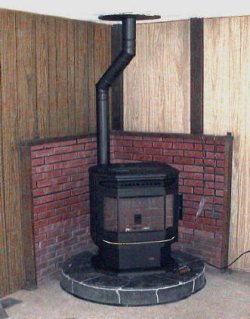stove pipe

Stove pipe runs from an appliance, such as a wood-burning stove, pellet stove, or coal stove, to where the flue goes through the ceiling or wall. It must then be connected to a safe chimney system to carry the products of combustion outside the house.
A common mistake is to assume that stove pipe should be installed with the male-end up because this is the way the smoke goes. However, if you fit it this way, you'll later find a black liquid – creosote – oozing down the pipe. Installing with male-end-down allows the creosote drippings to go back down into your stove instead of running down your pipe onto the stove or floor.
Stove pipe is pre-painted black, so tends to give off fumes when first used until the paint cures. Be sure to keep a window or door open during this time to let the fumes escape.
Single-wall stove pipe is used for most applications but only if the clearance to combustibles is at least 18 inches along the length of the pipe until it enters the chimney. Double-wall stove pipe is used where the clearance is less than 18 inches at any point along its length. Typically, double-wall stove pipe allows for 6 inches clearance from wall combustibles and 8 inches from ceiling combustibles. It's ideal when installing a newer close-clearance wood stove or appliance.
